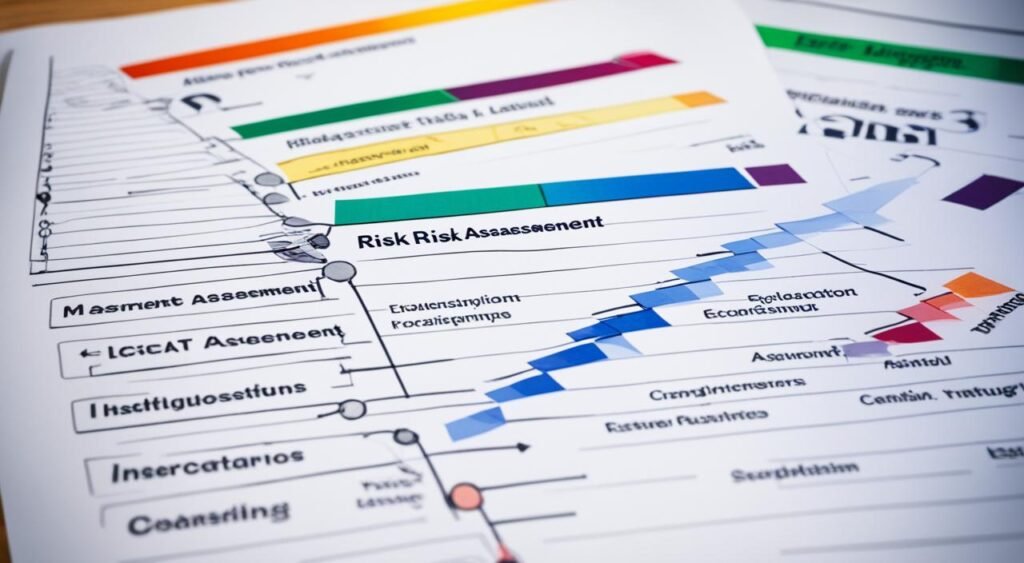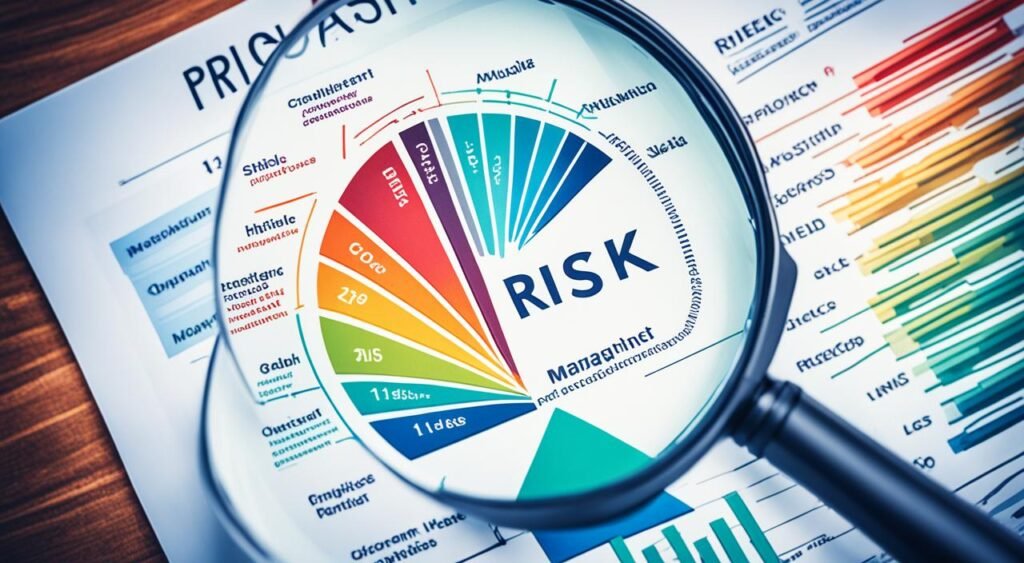Risk management is vital for insurance companies. It helps them stay financially stable. Also, it ensures they protect their assets and offer stable coverage to customers.
A good risk management plan looks at several important parts. These parts work together to spot, understand, and reduce possible risks. Knowing these components helps insurance companies. It lets them build a strong way to handle risks before they become problems.
Key Takeaways
- Risk management planning is crucial for insurance companies to ensure financial stability and reliable coverage.
- A comprehensive risk management plan includes key components such as risk identification, risk analysis and evaluation, risk treatment strategies, documentation and implementation, risk monitoring and control, and effective risk communication.
- By implementing a robust risk management plan, insurance companies can protect their assets and provide reliable coverage to their customers.
- Effective risk management helps insurance companies identify, analyze, and mitigate potential risks, ensuring they can fulfill their obligations to policyholders.
- Regular review and continuous improvement of the risk management plan are essential to address changing risk profiles and regulatory requirements.
Understanding Risk Management Plans
A risk management plan is vital for an organization. It shows how they handle risks. For insurance companies, this plan is key. It helps them protect their money and stay strong. With a good plan, they know what risks they face. They use their money wisely and make sure their business lasts long.
Definition and Benefits
A risk management plan is on paper. It lays out how a company spots, checks, and deals with dangers. The main pluses of having a plan are clear. It lets companies know what risks might come up. They can figure out how likely these risks are, how bad they might be, and come up with ways to deal with them. Plus, they can check if what they’re doing to avoid these risks is working.
Importance for Insurance Companies
For insurance firms, handling risks is super important. They deal with lots of dangers, from wild market swings and big rule changes to floods or mistakes in their operations. Good risk management means these firms follow rules, keep their good name, and offer solid plans to customers. Knowing the importance of risk management helps these companies choose well. This keeps them doing well for the long haul.
| Benefits of a Risk Management Plan | Importance of Risk Management for Insurance Companies |
|---|---|
|
|
“Effective risk management can help insurance companies maintain compliance, protect their reputation, and provide customers with reliable coverage.”
Identification of Risk Sources

A risk management plan for an insurance company starts with identifying risk sources. Risks come from many places, like the market, natural disasters, cyber threats, and changes in regulations. Also, the way a company works and its employees can create risks. Spotting these early helps companies manage and lessen their impact on business, money, and customer care.
Market risk is a big concern. It includes changes in interest rates, currency values, and the prices of assets. These changes can shake up an insurance company’s investments and financial health. Tackling market risk means keeping an eye on economic signs and how the market is moving. It also involves figuring out how different financial tools affect the company.
Then, there are operational risks. These come from inside the company and can be about data safety, system failures, fraud, or bad employee behavior. Taming these risks needs a close look at how well the company manages data and workers. Training staff and overseeing their work is key here.
Natural disasters bring their own set of risks. Places prone to hurricanes, earthquakes, or wildfires can suffer a lot. Such events often lead to more claims and might even threaten a company’s financial health. Managing these risks involves digging into past events, looking at where the business operates, and considering how climate change might make things worse.
Knowing about different types of risks and where they come from is crucial for insurance companies. With this basic knowledge in place, they can build a strong plan to face these threats. So, identifying risks is just the first step. Then comes analyzing, evaluating, and deciding how to deal with them.
Risk Analysis and Evaluation

First, insurance companies identify risk sources. Then, they look at how likely and how big each risk is. They do this by both guessing qualitative risk analysis and using numbers quantitative risk analysis. These methods examine risks differently but together give a full picture.
Qualitative Risk Analysis
This method uses expert judgment to guess risk levels like high, medium, or low. It’s a good way to understand risks’ nature and seriousness. However, it doesn’t have the exact numbers that quantitative methods do.
Quantitative Risk Analysis
Now, quantitative risk analysis brings in numbers to figure out how probable and big risks are. It uses techniques like statistical analysis and simulations. This method is more precise and gives an evidence-based view.
Using both methods, insurance companies get a full look at their risks. They then know which risks are most important and can focus their management efforts well. This way, they can handle risks better.
“Effective risk analysis and evaluation is essential for insurance companies to make informed decisions and effectively manage their risk exposure.”
When facing risks, insurance firms should look at both the big picture and the details. This helps in figuring out and handling the most important risks well. In the end, it protects the people they insure and keeps their business strong for the future.
Risk Treatment Strategies
Insurance companies can handle risks using several strategies. They can avoid, reduce, transfer, or accept risks. The best choice depends on the risk and the company’s resources.
Risk Avoidance
Avoiding risk means staying away from things that might be dangerous. This can mean not doing certain risky activities or not selling risky products. It works well to completely get rid of a risk, but it can also slow down how much an insurance company can grow.
Risk Reduction
Reducing a risk is about making it less likely or harmful. Insurers can put in place strict rules, work on preventing losses, or sell more types of insurance. Lowering risks helps insurance companies deal with the chance of big losses better.
Risk Transfer
Transferring a risk means making someone else deal with it. Insurers can pass risks to companies that help with insurance, like reinsurers. They often do this by paying these companies to take on some of their risks. Reinsurance is a key way insurers handle really big risks.
Risk Acceptance
Sometimes, an insurer just has to face a risk. This is when they can’t avoid, reduce, or transfer it. They prepare to deal with any losses by saving up money. It may look like doing nothing, but sometimes this is the best choice when other ways of dealing with a risk are too expensive.
Finding the right way to address a risk involves looking at the risk itself and what it could do. Then, insurers consider what they can do to manage it, based on their resources. This careful thought allows insurers to create effective plans for handling risks, keeping their business safe.
Documentation and Implementation

Creating a risk management plan is crucial for insurance companies. But, it’s not enough. They need to document and implement the plan well. This is key for the plan to work within the organization.
Documenting the risk management plan means defining who does what. It includes setting up good ways for everyone to talk and making sure the plan fits with the company’s main goals. This way, everyone knows their job in managing risks, and they work well together.
To implement the risk management plan, companies must take real steps to use the strategies they’ve written down. This can involve training, getting the right resources, and setting up how to check if the plan is working. It’s also important to review and update the plan often. This helps keep it useful and ready for changes in risks, laws, and the market.
Regularly reviewing the risk management plan is important. It helps companies see how well the plan is doing. They can then find ways to make it better and actually make those changes. This makes their risk management skills stronger over time.
In short, getting a risk management plan written and used well is vital. Doing this helps in the long run. By making sure everyone knows their role, talks well, and works on managing risks together, companies can build a strong risk management culture.
Risk Monitoring and Control
Watching and managing risks is key for insurance companies. They need to keep an eye on their risk levels to stay effective. This is done by using different tools and methods to review their risks and make quick changes when necessary.
Risk Management Tools and Techniques
Insurance firms have several ways to check and handle their risks. Some common ones are:
- Risk Register: A detailed list of all known risks, including their chances, impacts, and how they’re being dealt with.
- Risk Matrix: A map for risks shows which ones might happen and what could go wrong. It helps decide where to focus first.
- Risk Dashboard: A live, data-based snapshot of an insurer’s risk scene. It gives a fast look at what threats are growing.
- Risk Reports: In-depth papers that look at risk patterns, how well controls work, and how to do better.
These tools and techniques are crucial. They help insurance companies spot changes in risk levels and how well treatments work. By checking risks often, they can tweak their plans quickly. This keeps things up to date and working well.
“Effective risk monitoring and control are essential for insurance companies to maintain a comprehensive understanding of their risk profile and adapt their strategies accordingly.”
Actively managing risks aligns an insurance company’s safety plans with what they aim to do and what’s required by rules. This boosts their strength and success.
Risk Management

Insurance companies must always aim for the best when managing risk. They should keep getting better at what they do. To do this, they need to make sure everyone in their company knows about risk. This means teaching employees everything they need to handle risk well and checking how well their risk plans work from time to time.
Being open about risk is key to managing it well. Companies should make it easy for everyone to talk about risks. By letting each employee be a part of spotting and dealing with risks, a company becomes stronger against challenges.
Communicating Risk Strategies
Explaining the company’s risk policies clearly is very important. Everyone from the top bosses to the newest workers should know their part in keeping risks under control.
Ongoing Risk Management Training
- Give training that fits the needs of various jobs, helping everyone get better at handling risks.
- Also, keep pushing for more learning to make everyone better at managing risks.
Evaluating and Improving Risk Management
Always looking at how your risk plan is doing is a must. Things change all the time, like new laws or new tech. So, companies must stay sharp by keeping watch on what’s new and doing better with that knowledge.
| Best Practices for Continuous Improvement in Risk Management | Benefits |
|---|---|
| Regularly review and update the risk management plan | Ensures the plan remains relevant and adaptable to evolving risks |
| Conduct risk management audits and assessments | Identifies areas for improvement and opportunities to enhance the risk management framework |
| Implement data-driven decision-making | Enables more informed and effective risk management strategies |
| Invest in risk management technology and tools | Enhances the efficiency and accuracy of risk identification, assessment, and mitigation |
Following the best techniques and always improving makes insurance companies ready for whatever risks come in the future. It helps them stay strong and successful for a long time.
Role of Risk Management in Insurance
Risk management is extremely important in insurance. It helps companies keep their money safe while serving customers well. This keeps them strong and trustworthy.
Risk management strategies are crucial. They let insurers find and deal with dangers to their business. With a solid plan, they can use their resources wisely and follow the rules. This means customers get the protection they need.
A good risk management plan makes insurers stand out. It makes them known for their reliability and trustworthiness. When they show they take risks seriously, it makes everyone feel more secure.
“Effective risk management is not just a compliance requirement for insurance companies, but a strategic imperative that can unlock significant value and competitive advantage.”
Tackling risks head-on helps insurance companies thrive. It allows them to handle the ever-changing market well. This sets them up for success in the long run.
Also Read: Get Very Cheap Car Insurance – Top Savings Tips!
Conclusion
In conclusion, insurance companies must have a strong risk management plan. This helps them deal with risks that are always changing. They do this by knowing what risks could happen, seeing how likely they are, and what they might cost. They then make plans to handle these risks and keep an eye on things to ensure they are doing well.
It’s important for insurance firms to follow the best ways and make everyone aware of risks. This makes them able to do well in the long run and stay ahead. The important things in insurance risk management are having a detailed risk management plan. Also, they need to always look for and think about risks. And they should use good plans to lower the risks.
Using a smart and active risk management plan is key for insurance companies. This lets them face the many challenges and changes in business today. It protects their business and makes sure they are valuable to those they serve.
FAQs
What are the key components of a risk management plan for insurance companies?
Risk management plans for insurers include several key parts. These are risk identification, analysis, and evaluation. Also, they involve coming up with ways to treat risks, document the plan, and put it into action. Monitoring risks and communicating about them to stakeholders is essential too.
What is a risk management plan and what are its benefits?
A risk management plan outlines how organizations find, review, and handle risks. For insurance firms, having this plan lets them see risks early, check their likelihood and impact, make strategies to deal with these risks, and keep an eye on their risk management efforts.
Why is risk management particularly crucial for insurance companies?
Risk management is vital for insurers due to the many risks they face. These can range from market changes to natural disasters. A solid risk management plan helps insurance companies understand their risks, use resources well, and keep their business strong over time.
What are the steps in developing a risk management plan?
The steps in making a risk plan for insurance include finding where risks come from. Then, they look at how likely risks are and what they could do. After, they make ways to deal with these risks, write it all down, and put it in place. Finally, they keep an eye on risks and control them.
What are the main risk treatment strategies used by insurance companies?
Insurance companies often avoid risks, lessen them, transfer them to others, or sometimes just accept them. What they decide to do depends on each risk, how big its impact could be, and what kind of help they have.
How do insurance companies ensure effective implementation and monitoring of their risk management plan?
For their risk plan to go well, insurance firms spell out who does what, talk clearly, and tie the plan to their business goals. They use tools like the risk register, matrix, dashboard, and reports. These help them keep an eye on risks and how well their strategies work.
What are the best practices for insurance companies to improve their risk management capabilities?
To get better at managing risks, insurance companies should get their people to see and act on risks. They should also teach their staff about handling risks, check how good their risk plan is, and update it with new tech and rules.
